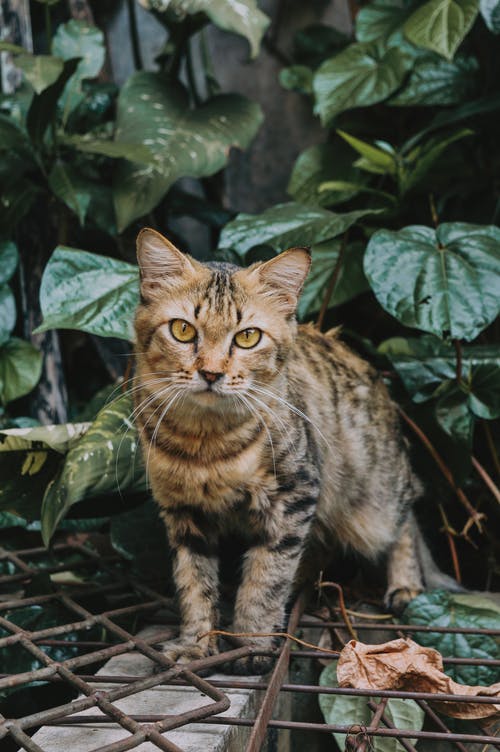
CATS GETTING IN YOUR TRASH?
REASON: CATS ARE LOOKING FOR FOOD
Secure your trash can with a tight lid or bungee cords. This will protect your trash from wildlife as well.
Find out if neighbors are feeding the cats. If they are, make sure they are following best practices.
Consider feeding the cats yourself if you find no regular caregiver. Feeding cats using best practices will help ensure they don’t get hungry enough to get into trash.
CATS ARE DIGGING IN YOUR GARDEN?
REASON: IT'S CAT’S NATURAL INSTINCT TO DIG IN SOFT OR LOOSE SOIL, MULCH, OR SAND.
Put out fragrances that keep cats away. Scatter fresh orange or lemon peels. Wet coffee grounds—which you may be able to get for free from coffee houses and fast food chains—and metal pans filled with vinegar also deter cats.
Make an outdoor litter box away from your garden by tilling the soil or placing sand inan out-of-the-way spot in your yard. Clean the area frequently.
Use plastic carpet runners, spike-side up, covered lightly in soil. They can be found at hardware or office supply stores. You can also set chicken wire firmly into the dirt (roll sharp edges under), arrange branches or sticks in a lattice pattern, or put wooden or plastic fencing over soil.
Get the Cat Scat Mat, a nonchemical cat deterrent consisting of plastic mats that are cut into smaller pieces and pressed into the soil. Each mat has flexible plastic spikes that are harmless to cats and other animals but discourage digging.
Get motion-activated sprinklers.
Cover exposed ground in flower beds with large river rocks to prevent cats from digging. Rocks have the added benefit of deterring weeds.


CATS ARE LOUNGING IN YOUR YARD, PORCH OR CAR?
REASON: CATS TEND TO REMAIN CLOSE TO THEIR FOOD SOURCE.
Shift the cats’ food source to a less central location, where you won’t mind if they hang out.
Apply fragrances that deter cats around the edges of your yard, the tops of fences, and on any favorite digging areas or plants. See above for a list of cat-deterring fragrances.
Install an ultrasonic deterrent or a motion-activated sprinkler. You can find humanedeterrent products at garden supply stores.
Use a car cover or place carpet runners on top of your car to avoid paw prints.
CATS ARE SLEEPING UNDER YOUR PORCH?
REASON: CATS ARE LOOKING FOR A DRY, WARM SHELTER AWAY FROM THE ELEMENTS.
Provide covered shelter. Or, if the cats have a caregiver, ask the caregiver to provide covered shelter. Shelters should be placed in quiet areas away from traffic.
Block or seal the area where the cats enter with chicken wire or lattice, but only once you are absolutely certain no cats or kittens are inside.


FEEDING CATS ATTRACTS INSECTS AND WILDLIFE!
REASON: LEAVING FOOD OUT FOR TOO LONG CAN ATTRACT OTHER ANIMALS.
Feed the cats at the same time and location each day. They should be given only enough food to finish in one sitting. If another person is caring for the cats, ask them to follow these guidelines.
Keep the feeding area neat and free of leftover food and trash.
CATS ARE YOWLING, FIGHTING, SPRAYING, ROAMING, AND HAVING KITTENS!
REASON: THESE ARE MATING BEHAVIORS. ONCE THE CATS ARE SPAYED OR NEUTERED, THESE BEHAVIORS WILL STOP.
Conduct TNR for the cats. TNR stops mating behaviors and ensures no new kittens are born.
Find more information about TNR on our website.

.png)
5 EASY STEPS FOR HUMANELY DETERRING CATS
-
Talk to your neighbors. Determine whether the cats are pets, stray, or feral, and if they have been spayed or neutered. If not, make an appointment with LICKS by calling (516) 431-8794.2.
-
Apply nontoxic deterrents around your yard.
-
Put a tight lid on your trash can
-
Block gaps in the foundation of sheds and porches.
-
Use a cover to keep paw prints off your car

DONATIONS NEEDED MEOW!
Please help us end the overpopulation and suffering of unwanted cats and kittens.
HELP US MAKE A DIFFERENCE!
